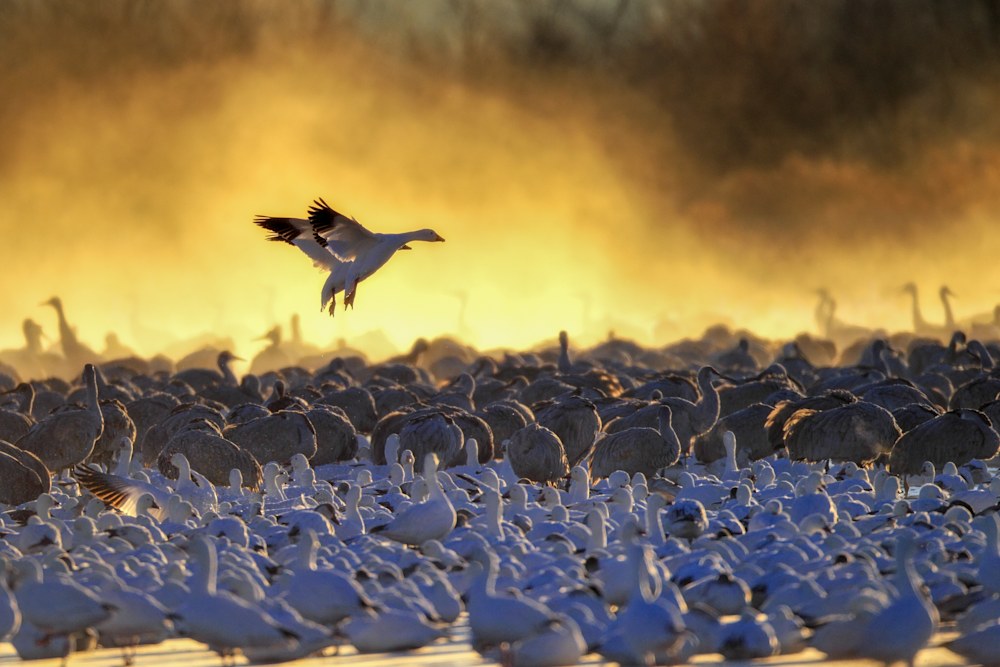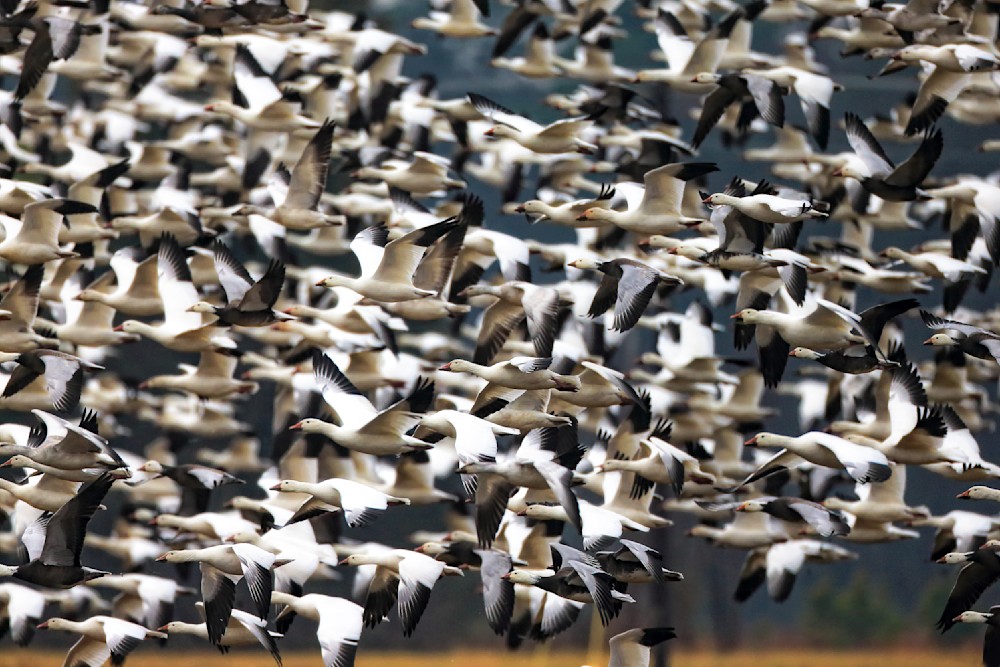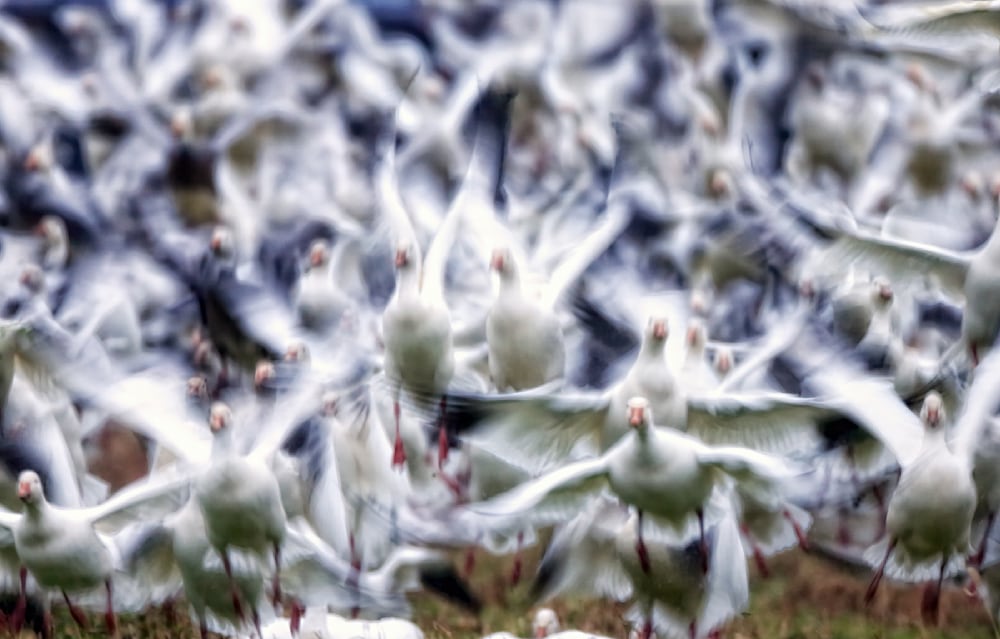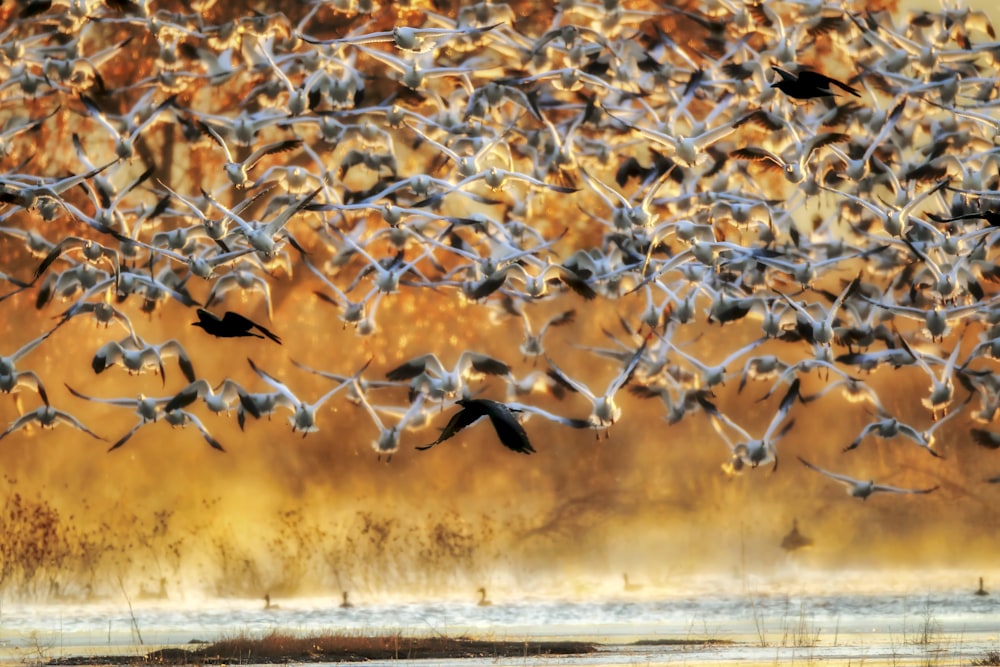Snow Goose, Anser Caerulescens: Facts, Behavior, Migration & More!
As a passionate wildlife photographer at Robbie George Photography, I've always been captivated by the ethereal beauty and remarkable journeys of the snow geese, Anser caerulescens. These birds are not just a feast for the eyes with their striking white plumage, but also a symbol of nature's incredible patterns, especially during their awe-inspiring annual migration. Join me as we delve into the intriguing world of these magnificent creatures, exploring their unique behaviors, diverse habitats, and the significant role they play in our ecosystems. From their intricate social structures to their vital conservation efforts, let's embark on an enlightening adventure to understand why snow geese continue to fascinate birdwatchers and nature enthusiasts around the globe.
Ever wondered about the mesmerizing sight of thousands of snow geese taking flight? Get ready to delve into the fascinating world of anser caerulescens, also known as snow geese. These stunning creatures are a spectacle to behold, especially during their annual migration. From their striking white plumage to their distinctive honking calls, there's so much more to these birds than meets the eye.
Join us as we explore the remarkable behaviors and habitats of snow geese, uncovering why they capture the imagination of bird enthusiasts worldwide. We'll take a closer look at their migratory patterns, feeding habits, and conservation efforts aimed at protecting these magnificent avian travelers. So buckle up for an exhilarating journey through the enchanting realm of snow geese!
Snow Goose Overview
Taxonomy
The snow goose, scientifically known as Anser caerulescens, belongs to the family Anatidae and the order Anseriformes. This species includes two subspecies: the greater snow goose and the lesser snow goose. These geese are classified based on their physical differences, such as size and coloration.
Physical Traits
Snow geese are recognized by their striking white plumage with contrasting black wingtips. They have a moderate-sized body, long neck, and a distinctive pink bill. Their feet stand out with vibrant orange or pink hues, adding to their unique appearance in their natural habitats.
Geographic Range
These magnificent birds breed in the Arctic regions of North America, specifically in Canada and Alaska. During winter months, they embark on extensive migrations to southern parts of North America, including the United States and Mexico. Interestingly, certain populations of snow geese also make remarkable journeys across continents to reach Asia for specific periods.
Habitat Preferences
In terms of nesting preferences, snow geese favor coastal areas characterized by tundra landscapes and marshes where they can establish secure breeding grounds for their offspring. However, during migration seasons, these adaptable creatures can be found exploring a variety of habitats ranging from agricultural fields to wetlands and lakes that offer abundant food resources necessary for sustaining them throughout their journey.
Identification of Snow Geese
Adult Morphs
Snow geese, also known as Anser caerulescens, are characterized by their white plumage and black primary feathers on their wings. They possess a distinctive "grinning" patch of black feathers around their bills. The size of adult snow geese can vary between the greater and lesser subspecies.
These birds' striking appearance makes them easily recognizable in flight or while foraging in fields. The contrast between the white body and dark wingtips is a key feature that distinguishes them from other waterfowl species.
Juvenile Morphs
Juvenile snow geese exhibit grayish-brown plumage with hints of white, providing effective camouflage against predators in their natural habitat. Their bills are initially dark-colored but gradually turn pink as they mature into adults.
The adaptive coloration of juvenile snow geese serves as a protective mechanism, allowing them to blend seamlessly into marshes and grasslands where they spend much of their early lives.
Comparison with Similar Species
Distinguishing snow geese from similar species involves noting specific characteristics such as their white plumage coupled with black wingtips. This distinct combination sets them apart from other waterfowl commonly found in similar habitats.
One closely related species often mistaken for the snow goose is Ross's goose, which resembles a smaller version of its larger counterpart. Furthermore, it's essential to note that there exists a blue morph variant within the snow goose population that displays bluish-gray plumage rather than the typical white morph.
Behavior and Communication
Social Structure
Snow geese, also known as Anser caerulescens, exhibit fascinating social behavior. During migration and wintering periods, these birds form large flocks that can consist of thousands of individuals. Within these flocks, snow geese establish a hierarchical social structure, where dominant individuals have priority access to resources such as food and nesting sites. This hierarchy helps maintain order within the flock and ensures survival during their travels.
Moreover, snow geese are highly monogamous creatures. Breeding pairs often mate for life, forming strong bonds with their partners. This loyalty plays a crucial role in the successful rearing of offspring and contributes to the stability of their social structure.
In terms of family dynamics, this loyalty is evident in how breeding pairs work together to protect their nests from predators while raising their young. The collaborative efforts between mates showcase not only monogamy but also teamwork within snow goose families.
Vocalizations
Communication among snow geese primarily occurs through various vocalizations that serve different purposes within the flock's dynamics. These vocalizations include distinct sounds such as honks, clucks, barks, and other calls that convey specific messages to other members of the group.
The diverse range of vocalizations allows them to express different emotions or intentions effectively. For instance, honking may signal excitement or alertness while clucking could indicate contentment or reassurance among each other.
Additionally,the sounds produced by snow geese travel over long distances, enabling effective communication across vast areas where they congregate during migration or at wintering grounds.

Life Cycle and Reproduction
Breeding Habits
Snow geese, also known as Anser caerulescens, typically breed in colonies or rookeries located in the Arctic regions. The female snow geese construct their nests on the ground using plant materials, and they line them with down feathers to provide warmth and protection for their eggs. During the mating season, both male and female snow geese engage in elaborate movements and calls as part of their mating displays.
These displays include synchronized head-bobbing, neck-stretching, honking, wing-flapping, and other intricate movements that showcase their readiness to mate. These behaviors help establish pair bonds between males and females within the colony.
Development Stages
After an incubation period of about 22 to 25 days, snow goose eggs hatch into fluffy white goslings. These chicks are precocial birds which means they are born with a full coat of down feathers and are able to walk shortly after hatching. They quickly learn to feed themselves by grazing on grasses or sedges near water bodies.
Within a few weeks after hatching, the goslings undergo rapid growth as they develop flight feathers necessary for flying. This remarkable growth allows them to keep up with their parents during seasonal migrations from breeding grounds to wintering areas.
As young snow geese continue growing through juvenile stages into adulthood, they gradually acquire distinct plumage patterns characteristic of adult snow geese.
Migration Patterns
Seasonal Movements
Snow geese, also known as Anser caerulescens, are renowned for their remarkable spring migration. These birds embark on extensive journeys between their breeding and wintering grounds. During this time, they form impressive V-shaped formations in the sky, a strategy that helps them capitalize on aerodynamic advantages, making their long flights more energy-efficient. This formation allows each bird to catch the updraft created by the bird in front of it.
The timing of snow geese migrations is heavily influenced by changes in food availability. As spring arrives and temperatures rise, these birds begin their journey northward to take advantage of the abundant food resources available during this season. Conversely, when fall approaches and conditions become less favorable for feeding, they make their way back south to seek out warmer climates and better sustenance.
Migration Challenges
Despite being seasoned migratory travelers, snow geese encounter numerous challenges during their journeys. Adverse weather conditions such as strong winds or storms can impede their progress and force them to alter course or temporarily halt their travels until conditions improve.
Moreover, these magnificent creatures face predation risks from natural predators like foxes or wolves along with human-induced threats such as hunting practices which can disrupt flocks during migration.
Habitat loss and disturbance along migration routes have also emerged as significant hurdles for snow geese populations worldwide. Human activities near crucial stopover points can lead to habitat degradation or destruction—factors that may ultimately hinder the success of these animals' annual migrations.
As climate change continues to impact ecosystems globally, it poses an additional threat to snow goose migrations. The altered patterns of temperature and precipitation could affect the availability of food resources at critical times throughout the year; thus influencing not only where but when these birds migrate.
Ecology and Ecosystem Roles
Food Sources
Snow geese, also known as Anser caerulescens, are primarily herbivores that rely on plant material for sustenance. Their diet includes grasses, sedges, and aquatic vegetation. During migration, they also consume agricultural crops such as grains and tubers. This diverse diet allows them to adapt to various environments, making them highly successful in different habitats.
The feeding behavior of snow geese can have both positive and negative impacts on their habitats. While their consumption of plant material helps control the growth of certain vegetation, it can also lead to overgrazing in some areas. The balance between their foraging activities and the preservation of natural ecosystems is crucial for maintaining a healthy environment for other species.
For example, when snow geese feed on an abundance of grasses in one area during migration, it may result in the depletion of resources for other wildlife species that depend on those grasses. On the other hand, by consuming certain invasive plant species or preventing excessive growth of vegetation, snow geese contribute to maintaining ecological balance.
Environmental Impact
Snow geese play a significant role in shaping their breeding and wintering habitats through their feeding habits. Large flocks have the potential to cause habitat degradation due to overgrazing of vegetation. This impact is particularly evident during their breeding season when they gather in dense concentrations.
The nutrient-rich droppings left behind by snow geese can enrich the soil with essential nutrients like nitrogen and phosphorus. This enrichment benefits certain plant species by promoting growth and enhancing overall ecosystem productivity. However, excessive accumulation of droppings can lead to nutrient imbalances or alter soil composition if not managed properly.
In regions where snow geese congregate during wintering periods, such as coastal marshes or wetlands, their presence influences the distribution and abundance of various plants within these ecosystems. While this influence can be beneficial for some native flora through nutrient deposition from droppings, it may pose challenges for others due to intense grazing pressure.
To illustrate further environmental impact - In areas where large populations gather during migration stops or wintering periods – there might be visible signs like stripped vegetation caused by extensive grazing activity leading to habitat alteration.
Conservation Status and Management
Protection Efforts
Conservation organizations and governments have been working tirelessly to protect snow geese and their habitats. For instance, they have initiated habitat restoration projects to ensure that the areas where snow geese live are healthy and sustainable. These organizations closely monitor the population trends of snow geese to understand their behavior and needs better.
Moreover, hunting regulations play a crucial role in ensuring the sustainable harvest of snow geese. By implementing specific rules for hunting these birds, authorities can prevent overhunting while still allowing for responsible management of populations. This approach is vital in maintaining a balanced ecosystem without causing harm to the species or its environment.
Regulatory Measures
Governments have implemented various regulatory measures to manage snow goose populations effectively. One such measure includes establishing hunting seasons with specific timeframes during which hunters are allowed to pursue these birds. These designated periods help maintain control over the number of snow geese harvested each year.
Furthermore, bag limits are set by wildlife services as part of their efforts to regulate snow goose hunting activities. These restrictions dictate the maximum number of birds an individual can hunt within a specified timeframe, contributing to population management strategies.
In some areas, special permits may be required for individuals who wish to engage in snow goose hunting activities. This additional layer of regulation ensures that only those who adhere to strict guidelines and demonstrate responsible behavior are permitted to hunt these migratory birds.
International agreements like the Migratory Bird Treaty Act provide legal protection for snow geese, emphasizing cooperation between countries in safeguarding these avian species across their migratory routes.
The collaborative efforts between conservation organizations, governments, and wildlife services reflect a commitment towards preserving not just individual species like snow geese, but also entire ecosystems on which they depend.
Economic Impact on Humans
Agricultural Relations
Snow geese, also known as Anser caerulescens, can pose a significant threat to agricultural crops, especially during their migration. The snow geese feed on grains, grasses, and other vegetation found in farmlands, causing damage to the fields. Farmers often face challenges in protecting their crops from snow goose depredation.
To manage the impact of snow geese on agriculture, farmers employ various methods such as scare devices and habitat modification. Scare devices include tools like propane cannons or visual deterrents that aim to discourage the presence of snow geese in crop areas. Some farmers implement habitat modifications by altering wetland environments or creating designated feeding areas for snow geese to minimize damage to other crops.
Moreover, while snow goose migration may lead to agricultural challenges for some farmers, it also presents opportunities for others. In regions where snow geese congregate during migration periods, ecotourism activities related to birdwatching and nature observation become popular. This creates an economic benefit for local communities through increased tourism.
Ecotourism Benefits
The presence of snow geese attracts birdwatchers and nature enthusiasts who are eager to witness the spectacle of large flocks of migrating birds. As a result, guided tours and wildlife festivals centered around snow goose migration have gained popularity in certain regions where these birds are prevalent.
These ecotourism activities not only contribute positively to local economies but also serve as platforms for education and conservation awareness initiatives. Visitors participating in guided tours or attending wildlife festivals gain insights into the importance of preserving natural habitats that support migratory bird species like the snow goose.
Population and Health
Population Statistics
The population of snow geese has surged significantly in the last century, especially for greater snow geese due to conservation efforts. This rapid growth has resulted in high population densities, leading to competition for resources and potential impacts on other species. The increased numbers have also led to overgrazing of their tundra breeding grounds, affecting plant communities.
In some areas, the large populations of snow geese have caused damage to their habitats by consuming too much vegetation. For example, they have denuded significant portions of their Arctic breeding grounds as a result of overgrazing. This can lead to habitat degradation and impact other wildlife that depend on those same habitats.
Lifespan and Home Range
Snow geese typically live for about 10 to 15 years in the wild. They exhibit an impressive ability to navigate vast distances during migration with home ranges spanning thousands of kilometers. These migratory flights are not only awe-inspiring but also crucial for maintaining healthy populations by allowing access to diverse food sources across different regions.
Their extensive home range allows them access to various feeding and nesting sites throughout their life cycle while ensuring genetic diversity within the population through intermingling among different groups during migration periods.
Predation Factors
Snow geese face predation risks from several predators including Arctic foxes, polar bears, birds of prey such as eagles and hawks, wolves, coyotes, and even gulls which may target eggs or chicks directly at nesting sites. The formation of large flocks provides some protection against predators through increased vigilance since more individuals can be alert at any given time.
However, nest predation by mammals like foxes or avian predators can still impact reproductive success despite these measures taken by the flock collectively.

Summary
You've now got the lowdown on snow geese, from their characteristic white plumage to their impressive migration journeys. Understanding their behavior, life cycle, and ecological impact sheds light on the vital role they play in the environment. It's clear that these majestic creatures are not just a sight to behold but also crucial players in maintaining the balance of their ecosystems.
In conclusion, our journey through the captivating world of the snow geese at Robbie George Photography has offered us a profound appreciation for these majestic birds and their remarkable migration. Their resilience and adaptability not only reflect the wonders of the natural world but also remind us of our responsibility to protect these beautiful creatures and their habitats. As we continue to explore and photograph the diversity of wildlife, let’s carry with us the awe-inspiring image of the snow geese in flight, a symbol of nature's enduring beauty and strength. Keep following Robbie George Photography for more insights into the fascinating lives of wildlife, where every snapshot tells a story of conservation and the undying spirit of nature.
Now that you're in the know about snow geese, consider how you can contribute to their conservation. Whether it's supporting habitat preservation efforts or spreading awareness about their significance, every little bit helps in ensuring the well-being of these remarkable birds. Get involved and be a part of safeguarding the future of snow geese and the environments they call home.
Frequently Asked Questions
What is the average lifespan of a snow goose?
Snow geese typically live for around 10-15 years in the wild. However, some individuals have been known to live up to 20 years.
How do snow geese communicate with each other?
Snow geese use a variety of vocalizations and body language to communicate with one another. They honk, squawk, and flap their wings as part of their communication repertoire.
What is the economic impact of snow geese on humans?
The economic impact of snow geese on humans can be both positive and negative. While they provide opportunities for wildlife-related recreation such as birdwatching and hunting, they can also cause agricultural damage in certain areas.
How far do snow geese migrate during their annual migration?
Snow geese are known for their impressive long-distance migrations. They travel thousands of miles between their breeding grounds in the Arctic tundra and wintering areas in southern regions, such as the Gulf Coast.
What role do snow geese play in their ecosystem?
Snow geese play an important role in shaping wetland ecosystems through grazing activities. By feeding on vegetation, they influence plant communities and create habitats that benefit other species.






